According to New York Yimby, Mayor de Blasio's proposed inclusionary zoning policy could do more to protect small market-rate developments, without affordable housing, than it will to create affordable units.
Rebecca Baird-Remba reports on a loophole in a mandatory inclusionary policy announced in July by New York Mayor Bill de Blasio. First, to summarize the policy, Baird-Remba writes that the city "will require market-rate developers to set aside at least 25% of their units in each new building as affordable housing."
The loophole, however: "New buildings with 10 units or less won’t have to abide by the new mandatory affordable rules." That creates a problem in East New York, where the policy will first be rolled out. That's because, according to Baird-Remba, in East New York "virtually all new market-rate construction is three or four-story masonry structures with fewer than 10 apartments."
The reality of the market that, according to Baird-Remba, render the inclusionary zoning policy ineffective on that side of town: "Taller steel-frame buildings cost more to build and are more to challenging to finance, particularly if they have subsidized units. Rents in the area simply aren’t high enough to justify the cost." According to New York YMIBY's archive, in fact, just one market-rate building above that threshold has filed permits in East New York all year long.
The article then explains how the East New York rezoning process will proceed, with a major release expected on September 21.
Sally Goldenberg reported on the critical component of this developing story, Mayor Bill de Blasio's proposal for mandatory inclusionary zoning, at the end of July.
FULL STORY: The Loophole In De Blasio’s New Mandatory Inclusionary Zoning Policy

Planetizen Federal Action Tracker
A weekly monitor of how Trump’s orders and actions are impacting planners and planning in America.

Maui's Vacation Rental Debate Turns Ugly
Verbal attacks, misinformation campaigns and fistfights plague a high-stakes debate to convert thousands of vacation rentals into long-term housing.

San Francisco Suspends Traffic Calming Amidst Record Deaths
Citing “a challenging fiscal landscape,” the city will cease the program on the heels of 42 traffic deaths, including 24 pedestrians.

Amtrak Rolls Out New Orleans to Alabama “Mardi Gras” Train
The new service will operate morning and evening departures between Mobile and New Orleans.

The Subversive Car-Free Guide to Trump's Great American Road Trip
Car-free ways to access Chicagoland’s best tourist attractions.

San Antonio and Austin are Fusing Into one Massive Megaregion
The region spanning the two central Texas cities is growing fast, posing challenges for local infrastructure and water supplies.
Urban Design for Planners 1: Software Tools
This six-course series explores essential urban design concepts using open source software and equips planners with the tools they need to participate fully in the urban design process.
Planning for Universal Design
Learn the tools for implementing Universal Design in planning regulations.
Heyer Gruel & Associates PA
JM Goldson LLC
Custer County Colorado
City of Camden Redevelopment Agency
City of Astoria
Transportation Research & Education Center (TREC) at Portland State University
Jefferson Parish Government
Camden Redevelopment Agency
City of Claremont




























